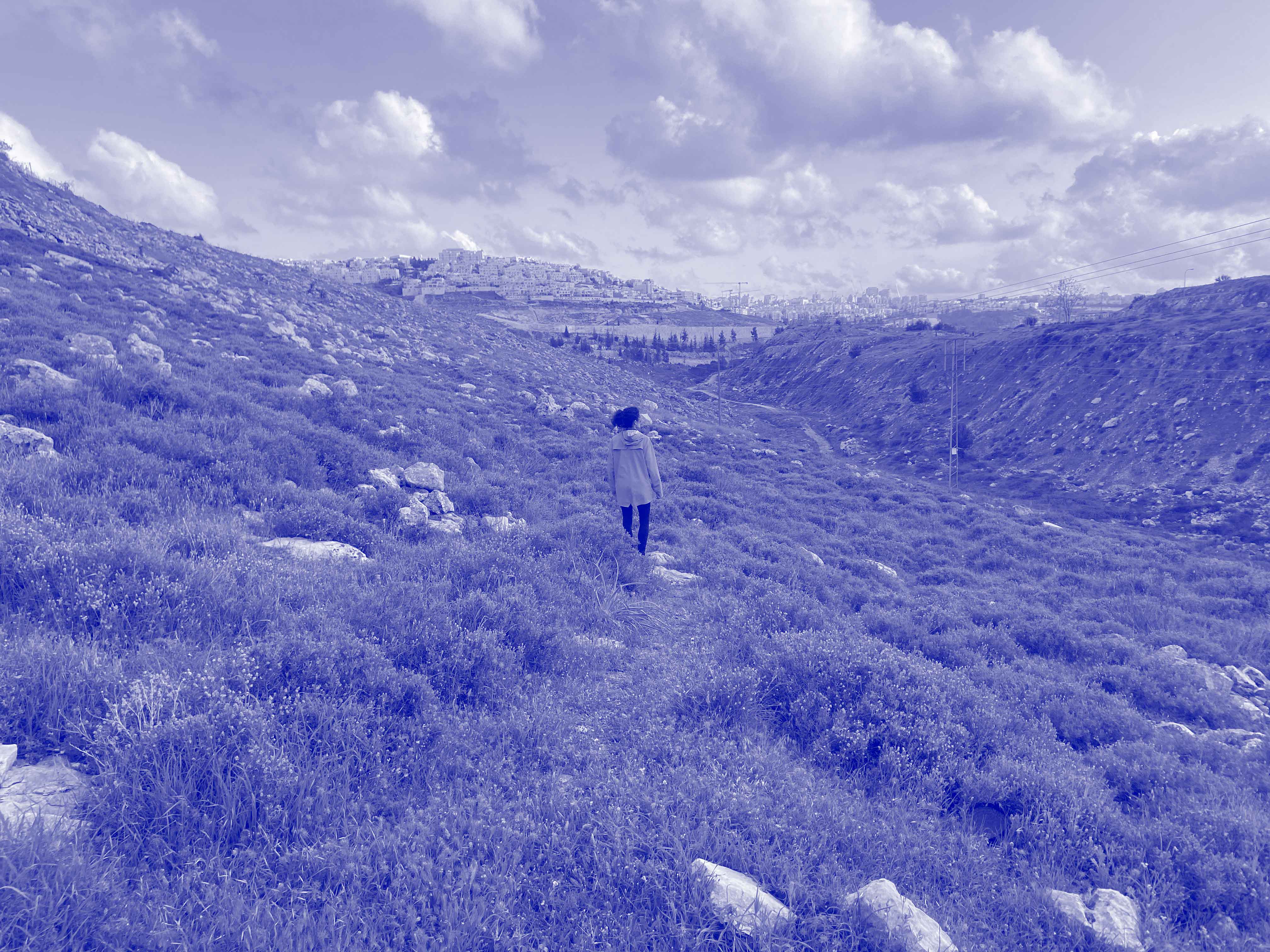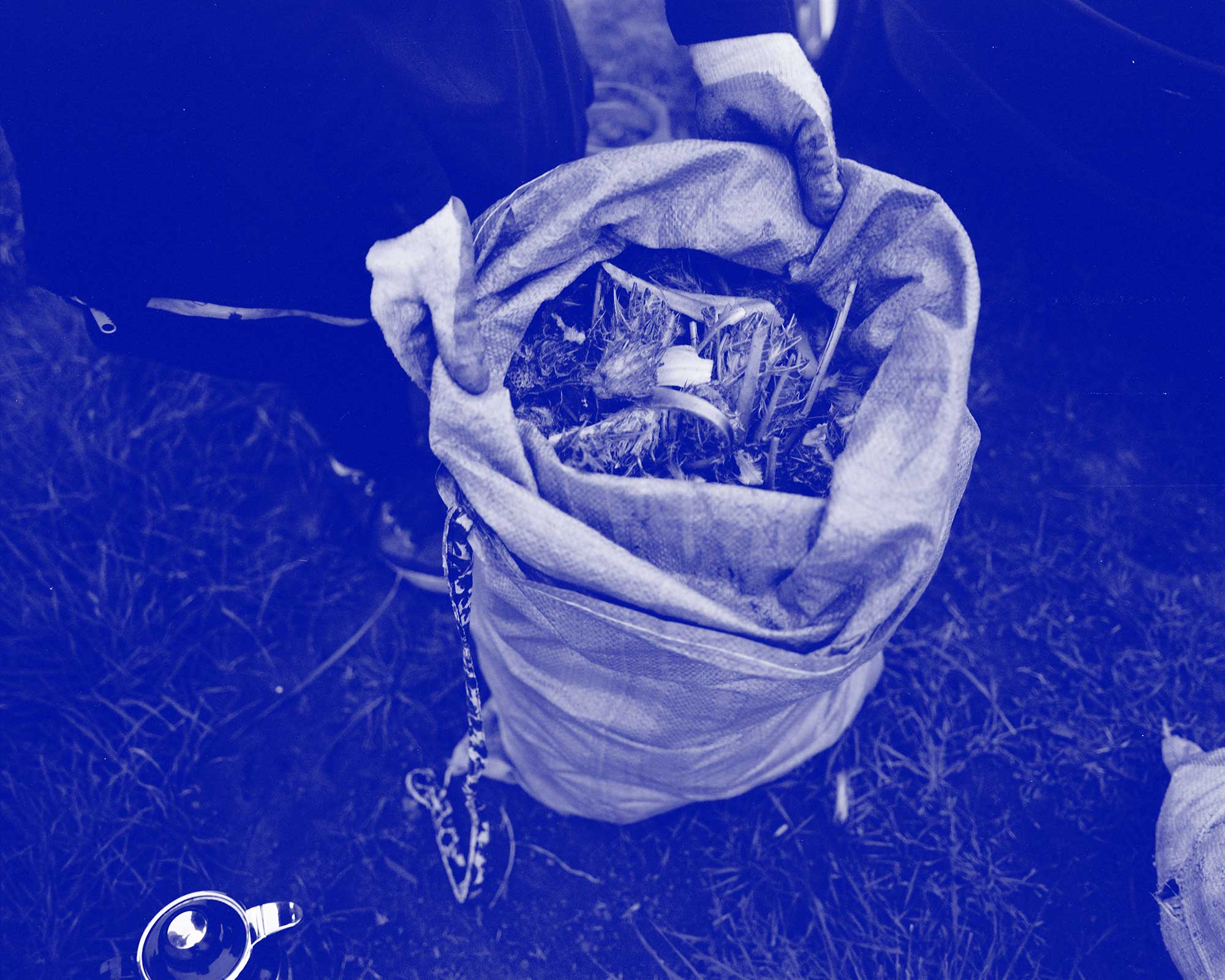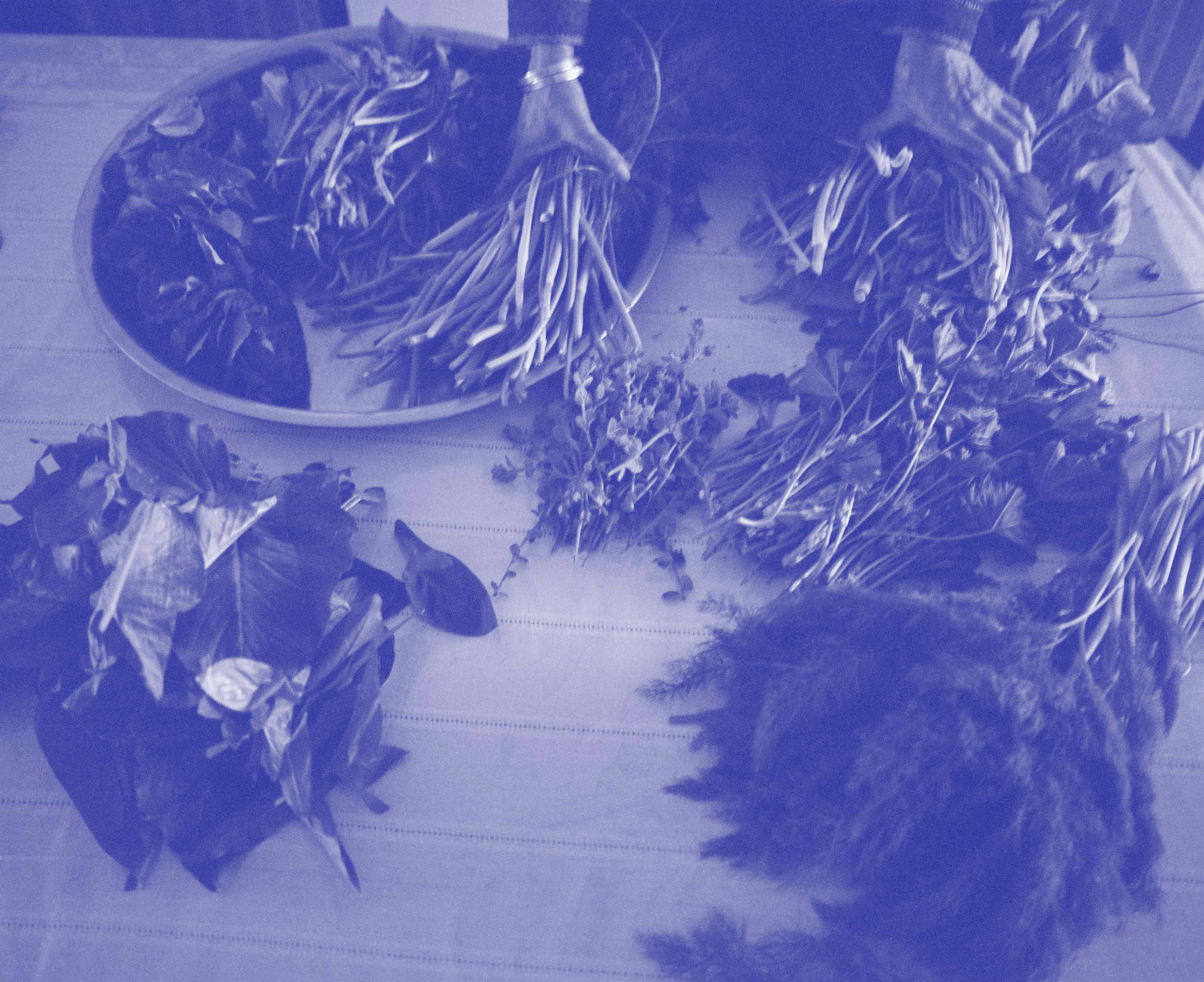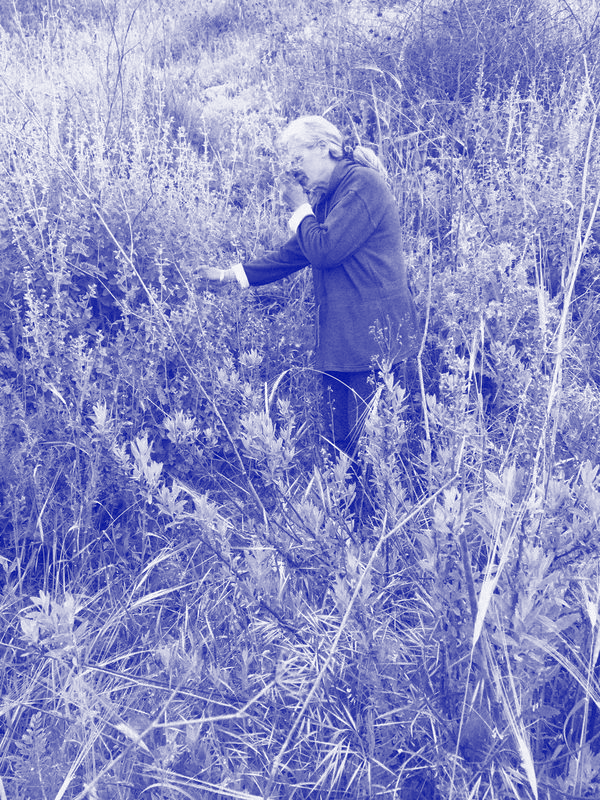Where Nature Ends and Settlements Begin
Jumana Manna
[Original text]
This piece was originally published in English on E flux journal, Issue #113, Novembre 2020, and reprinted in part with the permission of the author. L'Art Rue is presenting Jumana Manna's film, The Goodness Regime, as part of our curated program for the Festival d'Automne in Paris.

The Valley
I step outside my parents’ house in Shu’fat, a Palestinian neighborhood located on the historic Jerusalem-Ramallah road, about three kilometers north of the Old City of Jerusalem and walk westwards to the sahel (flat plane), through the old village, towards what remains of the olive groves that run beneath the bridges and alongside the highways exiting the city. I look at the limestone rocks peppered across the hills. They are inhabited by various growths, and marked by signs of former lives. Two palm-sized depressions are carved into a bed of limestone—ancient basins to collect rainwater for animals. There are rocks that indicate cave openings. Some contain signs of an oil or wine press, while others serve as habitats for plants, snails, the pods of microorganisms, and suntanning beds for lizards. To my surprise, gazelles regularly visit this valley, leaving little excretion pellets behind on their paths. We often meet and stop to exchange looks. I move closer; they run away.
A multitude of edible plants grow in this valley, as in much of the hilly landscape of Palestine/Israel. My parents, who forage frequently, both rave and complain about how quickly the fridge gets filled with greens that they have to wash, chop, and cook—before even going to the market. Between the months of February and May, they collect the following plants: khubeizeh (mallow), shomar (fennel), za’tar (thyme), ‘elt or hindbeh (dandelion), hummeid (bitter dock), loof (black calla), wara’ zquqiah or tutu (ivy-leaved cyclamen), halayoon (wild asparagus), and the much-celebrated ‘akkoub (gundelia). It is indeed possible to live off of these wild leaves and vegetables in the springtime and only go to the grocer for a bag of onions, salt, olive oil, and perhaps some grains. This novelty is particularly poignant in times like these, where supermarket racks and trollies are not only potential virus transmitters, but also a symbol of the world’s agricultural and ecological imbalance.
Many of the plants that grow in the region, once known as the Fertile Crescent, are wild relatives of the cultivated legumes that are sold in supermarkets today. The seasonal foraging practices here, as elsewhere, predate the rhythms of agricultural cultivation and state-imposed commercial and sovereign interests. Collecting wild-growing food was the backbone of human survival for millennia, and continued to be a daily practice alongside agriculture for just as long. In recent years, foraging has seen a resurgence of popularity across much of the world: for some, it’s a leisurely weekend activity, a way of being close to nature, and for others, a means of survival—a safety net in precarious times. Inheriting knowledge about plants from my mother brought little moments of happiness, accompanied by the joy of witnessing the transformations of spring, the growths and disappearances of flowers, smells and changes in light quality from week to week. I felt so fortunate to live this magic again. Throughout the quarantine, foraging became a hybrid performance of food sovereignty as well as culinary delight; it is for me an intimate practice that strengthened my sense of belonging and connection to the landscape.
Out of this plethora of forageable food growing in Palestine/Israel, the Israel Nature and Parks Authority (INPA) has listed three varieties as protected species: ‘akkoub (Gundelia tournefortii), za’atar (Majorana syriaca), and miramiyyeh (Salvia tribola). These are considered hard to find, as they grow in limited microclimates and are indeed often over-foraged. On my daily walks in the valley, I have made a new acquaintance, a shepherd named Abu Said. He has shared his knowledge of the area with me—a veritable embodied map of what edible food grows where. Most importantly, he’s pointed me to where ‘akkoub grows in large quantities, and so my mother and I equip ourselves with thick gloves, knives, and bags, and get ready for our excursion.
‘Akkoub tastes like a cross between asparagus and artichoke. It is a culinary obsession for many Palestinians, the utmost delicacy. For those who did not grow up eating it, however, it is simply an irrelevant thistle. Botanists have recorded the wide-ranging uses of this plant, and judging from its traces found at Neolithic sites in the region, its consumption dates back at least ten thousand years.¹ They say that ‘akkoub was mainly cooked like a vegetable, very much like we eat it today.² It is very rarely cultivated, and grows wildly on open limestone slopes and in reddish soil, from early February to early May, depending on elevation and rain patterns. It does not like turned-over soil, and wherever there are spills from construction sites or marks from screeching jeep tires, ‘akkoub is nowhere to be found. It is known for its wide range of health benefits: it can treat diabetes, liver diseases, chest pain, heart problems, stroke, gastric pain, diarrhea, and bronchitis. It is antibacterial, anti-inflammatory, antioxidant, and anticarcinogenic. By the summer, the ‘akkoub dries and tumbles through the hills, spreading its seeds, and only goats are left chewing through its parched leaves.
On our ‘akkoub hunt, my mother and I clip the thistle at its base, slightly below soil level. We strip away the thorny leaves, and once we make it home, we meticulously shave off the remaining spikes before cooking. Our fingers turn black during this process of getting to the edible heart of the plant. The heart, along with the thicker stems, gets sautéed with onions and olive oil, or cooked with pieces of meat, sometimes covered with a yogurt sauce. For me, ‘akkoub foraging and peeling is a Corona activity: a prickly passing of the time.
For as long as I can remember, we would get ‘akkoub from my aunts in the Upper Galilee. They would have already generously done the hard labor of cleaning the plant of its thorns, and we would prepare it for cooking. My aunts still live within the routines and time-space of rural life, wherein picking and peeling ‘akkoub is not considered time wasted. The plant also happens to be much more plentiful in the north, in Nablus, the Galilee, and most of all in the occupied Syrian Golan Heights. Only as an adult did I understand that my aunts, now in their seventies and eighties, are perpetual scofflaws. Picking ‘akkoub has been deemed illegal by the Israeli authorities since 2005, and if you ask Palestinians why that is, many would say that it is “because Arabs like it very much.”

Preservation under Zionism
Preservation measures have always been a double-edged sword. As our quarantine experience reminds us, every act of protection is accompanied by an erasure of another kind. The key question is often not whether to safeguard, but how and at what cost. In colonial contexts in particular, preservation laws have come as top-down decisions, imposed by the colonizer, armed with a claim to scientific expertise, and restricting the “destructive tendencies” of the “ignorant natives.” This dynamic has been particularly consistent in the national Zionist project, which has worked against the potential of a reciprocal exchange with the enemy other. Zionism has developed into an apartheid apparatus, a world cut in two, where the sovereign is in antagonism and vertical superiority vis-à-vis the Palestinian Arabs. Frantz Fanon likened master-subject relations in such colonial worlds to animal life, where relations never lead to an affective community or common realm.³ The master relegates his subjects to the category of lesser-than-human, thereby remaining forever untouched by their speech and subjecthood. In this symbolic structure, Palestinians are always on the receiving end, subjected to the law rather than subjects of its making. This sort of preservation impulse is particularly ironic in the case of the ‘akkoub ban, where a plant which is essential to northern Palestinian cuisine and unheard of by most Israelis, is protected from the threat of Palestinians. Yet again, Israeli officials have forgotten to ask us what we think.
To restore a site or an object to its assumed and ultimately imagined original state often entails a preservation effort that severs the thing from its living environment. National Zionism constitutes a restoration event, a Judeo-Christian messianic effort to selectively return what is believed to be the original, or “natural,” state of the land to Jewish hands, excluding others’, through the idealized modern configuration of being-in-common: the nation-state. In this ever-extending frontier—literally and conceptually, and along the lines of modernity at large—history-making has been a secularized version of messianic time.⁴ Zionism did not stop at uncovering an archaeological site, locating the travelling sound waves of the music of the Second Temple, or speculating about the mentioning of ‘akkoub and za’atar in the Old Testament. This teleological construct of a state has historically used preservation and protection measures to further legitimize its claims to the land and reinforce its self-image by all means and in all fields, not least through conceptions of “nature.”
The best-known example of a nationalized landscape—a reconfigured landscape designed to mirror the state’s image—is the extensive monocultural planting of pine trees funded by the Jewish National Fund (JNF). This practice grew commonplace when Palestine/Israel gradually became the homeland of Ashkenazi Jews, and Europe the object of nostalgia. “Making the desert bloom” was not a mere metaphor for the Zionist project; rather, by planting hundreds of man-made forests, Ashkenazis could imagine being back in Leipzig while living in Jerusalem.⁵ The majority of afforestation projects were intended not only to make the “primitive,” semi-arid hills of Palestine look more “civilized” according to European eyes, but also to erase the traces of the over four hundred Palestinian villages that were destroyed during the Nakba of 1948, after their inhabitants were forced into exile.
With the rise of environmentalism in the 1990s, the JNF realized that it was not just the Palestinians who were erased; much of the flora and fauna of these lands was decimated along with them.⁶ The intrusive acidity of the pine trees prevented other vegetation from growing back, and the over-prevalence of the pines increased the frequency and force of wildfires. This echoes disasters in Australia, North and South America, Portugal, and elsewhere. In California in particular, the erasure of indigenous American traditions of managed burning has caused an overgrowth of shrubbery, which, along with the spiking rates of global warming, has resulted in chronically uncontrollable fires. Today, Native American communities have partnered with the US Forest Service to steward land for traditional values and wildfire management.⁷ In a similarly revisionist vein, environmentalists realized that draining the swamplands of Hula, in Galilee, in the 1950s damaged the migration routes of millions of birds flying between Europe and Africa. So in the mid-nineties, it was partially re-flooded in an effort to bring them back. The past century has seen many examples of this kind of “misjudgment” and attempted repair: from desertification in the south—the Naqab/Negev—due to the depletion of groundwater resulting from the displacement of Bedouin populations, to grazing limitations that have affected Arab herders. Yet, unlike other settler-colonial contexts such as the United States, Canada, or Australia, when the paradigmatic shift towards the politics of sustainability began to take root in Israel, it was not accompanied by an official apology or acknowledgement of historical crimes committed. As slim and ineffectual as these utterances have been in the West, Israel has not yet admitted that the displacement of a people went hand in hand with violence committed against the land. Instead, the new “green” measures since the nineties have been co-opted into the historical rhetoric of protection, where the binary relations of power continue to be reinforced to this day.
Despite the above-mentioned environmental “mistakes,” there is some ecological basis to the fear that ‘akkoub, miramiyyeh, and za’atar may be going extinct in the wild, well beyond the specifics of Israel/Palestine. Elderly people throughout the country and in neighboring Jordan and Lebanon attest that these plants are much harder to find than they used to be. This new scarcity is also felt throughout Iran’s Isfahani province, where it has already become common to intentionally plant ‘akkoub because the market demand is higher than what wild growth can provide.⁸ Yet, like most looming extinctions of biological life, the driving factors are damage to habitat, population growth, urbanization, and climate change. When it comes to plant foraging, increased demand and unsustainable overharvesting are contributing factors, but are rarely primary causes. Professor Nativ Dudai, a botanist who has researched za’atar, confirms this in an interview:
No one talks about the fact that we, the Jewish [Israelis], destroy much more za’atar than the Arabs pick. Do you know how many great za’atar populations were uprooted by bulldozers? In Har Adar or Elyaqim interchange—locations with beautiful amounts of za’atar, and all of it is now gone. But the Arab? He picks five kilograms and gets a fine.⁹
Negotiating the politics of plant extinction with an occupier is always complicated, especially in the context of Palestine, where over the past seventy years Palestinians themselves have been treated as an invasive species in urgent need of elimination and control. The protection of one form of life—nonhuman life—has been used as an extra tool to suffocate a people who have survived attempts at cultural erasure and ethnic cleansing.
This is an ontological paradox: the same state that creates security lists, kill lists, terrorist lists, and other databases to “identify humans who risk to threaten” also establishes lists of nonhumans identified as threatened species, elevated to the political status of being in need of rescue.10 The necropolitical state of Israel builds illusions of freedom and democracy through enmity and destruction, through a will to kill, while simultaneously adopting environmental rhetoric that claims to protect nature as virgin land, conveniently failing to recognize Palestinians’ right to the land and self-determination. Instead, ancient Palestinian land practices are framed as an inherent threat to nature and thus the right of Palestinians to access that nature is revoked. In the contested landscape of Palestine/Israel, then, the continued collection of ‘akkoub and za’atar in the wild, despite and in spite of the ban, is an act of both survival and anti-colonial resistance. Foraging these plants is part of a bid to hold on to forms of memory and know-how that are fast eroding.

A Pause for Cat Orgasms
The hill on the Shu’fat side is full of wild edibles and other kinds of native spring plants. The hill on the settlement side, however, is bland, covered mostly by grasses, with upturned soil to create a clean and orderly slope. Needless to say, there is nothing edible here. Back on our side of the hill, behind an old dilapidated metal fence, we find so many za’atar “homes” that we can barely believe our eyes. By the look of it, no one has foraged here for years. So we do. Indulging in the process, we find another kind of thyme, one that is not illegal to pick: za’atar al-bisas, literally “cat za’atar” (its Latin name is Nepeta curviflora). This type of thyme is also known as “Syrian catnip” because of the pleasure cats get from licking it. Adorned with a substance that mimics their feline sexual pheromones, cats get high and euphoric from za’atar al-bisas. In effect, it gives them an orgasm. The cat begins licking the plant and then leaps around in it and purrs loudly. This lasts for a few minutes before the cat loses interest, potentially to return two hours later for another go.¹¹ Throughout the months of lockdown, my mother and I have returned frequently for new batches of ‘akkoub and za’atar, feeling like defiant mavericks, stealing moments of pleasure as we pick the plants that we love.

Aziza smelling Syrian catnip. Courtesy of the author.
Decolonizing Extinction Listings
When studying anthropogenic extinction, climate-justice researchers essentially seek to answer two central questions: Which forms of human life are driving processes of catastrophic loss? And what are the diverse ways in which humans and nonhumans have resisted this loss? The challenge is to move away from failed policing tactics to create a life-affirming culture of preservation and sustainability. What’s sorely needed is an epistemological change that decolonizes extinction and fundamentally reorients our relation towards each other and our surroundings. According to scholar Juno Salazar Parreñas, this decolonization must be “oriented towards process and experimentation and not toward foregone conclusion, except for the need to care enough about others, including and in particular, non-human others.”¹²
Unfortunately, most people today—and Palestinians are no exception—do not lead a life guided by cross-species care. Palestinian society at large is now detached from its historical intimacy with the land, which only two or three generations ago was a central part of Palestinian life. A seldom-discussed transformation caused by the Nakba of 1947–49—along with the massive expropriation of land that continued well afterwards—was the process of turning peasants (that is, historically speaking, the overwhelming majority of Palestinian society) into unskilled construction workers. This intentional and systemic transformation of an entire society is manifest today. One only has to drive through the West Bank to see the mutations of architecture and landscape brought about by private owners and the Palestinian Authority alike. My grandfather, who was illiterate and ended up a construction worker himself, learned lessons the hard way and repeatedly told my father to get a good education. “They can take your land and house away from you, but knowledge is yours to keep.”
The disregard for agrarian life was underway well before 1948. It began in the final decades of the dying Ottoman Empire, and it continued to spread under the British Mandate and the implantation of capitalist ideals of modern life that we have come to call “progress.” This “progress” slowly transformed land from something embedded in the sociopolitical fabric of a community into an extractable commodity. These ideals are still hard at work across an increasingly decaying planet.
Foraging, meanwhile, is an ancient method for recognizing and learning about the abundance of one’s surroundings. Since 9500–8000 BC, farmers have been selecting seeds from their favorite wild plants, planting them, and repeating the process until both seeds and humans were thoroughly domesticated. Over millennia, this grooming gradually changed the genetic makeup of both partners into the tastes, shapes, and faces that are familiar to us today. The wild relatives, or “weeds,” that live near fields where their cultivated descendants grow play time-travel games. Genetically speaking, these relatives are many thousands of years apart. We need to foster an imaginary that understands the depths of time embodied in these plants, an imaginary that is outside the logic of origins and the oppressive boundaries of the state. This imaginary would include a multitude of approaches to biodiversity: rewilding alongside “zoning,” with the aim of educating, building agency, and encouraging responsible—and joyful—foraging.¹³
We know that abolishing the police frees up massive amounts of public funding for implementing real structural change and building community strength through education, rehabilitation, and social support. In a similar vein, reallocating funds from law-enforcement bureaucracies and military forces towards education and biodiversity can support the changes necessary to disseminate plant-related knowledge and practices. This reallocation can also contribute to cross-border conservation strategies in regions where certain species are native. After all, seeds have always defied modern ideas of order, law, and borders.
This is one path towards a planetary democracy, or a democracy of the species—a possibility for freedom that breaks from slavery and colonialism in all their historical and contemporary forms. In this process, ecologies must be rebuilt and re-symbolized, so they are geared towards mutuality and affirmation, not exclusion. Only with this profound shift can preservation measures translate into a real attempt to protect life, rather than preserving the necropolitical regime already in place.
¹Hind, Nicholas. “Gundelia Tournefortii: Compositae,” Curtis Botanical Magazine 30, no. 2 (July 2013): 114–38.
² A lone German man travelling through the Levant is the first known Westerner to have illustrated and described the ‘akkoub, scientifically known as Gundelia tournefortii. In November 1573, Leonhart Rauwolf (lion heart, rough wolf) left Bavaria to begin his search for herbal medicine supplies in Tripoli, modern-day Lebanon. He continued from there to the “mighty city” of Aleppo, then to Baghdad and Mosul, before ending with a trip to Jerusalem. Rauwolf, relying on a description by the ancient Greek physician Discorides, mistook the Gundelia for milk thistle. A forgivable mistake really, as even locals today who eat ‘akkoub but aren’t involved in its collection commonly confuse it with other similar-looking thistles. Prussian and other European botanists built on Rauwolf’s Aigentliche Beschribung der Reise in die Morgenländerin (A true account of a voyage to the Levant). They noted how in the old Baghdad markets, the mature and hardened heads were eaten like nuts, and in some parts of Turkey and Iraq were used as a source of oil and gum.
³ Mbembe, Achille. “Fanon’s Pharmacy,” chap. 5 in Necropolitics (Duke University Press, 2019), esp. 153.
⁴ For more on the critique of techno-optimistic efforts enmeshed in Western end-time thinking, see Deborah Bird Rose, “Reflections on the Zone of the Incomplete,” in Cryopreservation, ed. Joanna Radin and Emma Kowal (MIT press, 2017).
⁵ Paraphrased from Carol Bardenstein, “Threads of Memory in Discourses of Rootedness: Of Trees, Oranges and Prickly-Pear Cactus in Palestine/Israel,” Edebiyat: A Journal of Middle Eastern Literatures 8, no. 1 (1998). Bardenstein is quoted in Irus Braverman, “Planting the Promised Landscape: Zionism, Nature, and Resistance in Israel/Palestine,” Natural Resources Journal 49, no. 2 (Spring 2009): 343.
⁶ Gutkowski, Natalia. “Governing through Timescape: Israeli Sustainable Agriculture Policy and the Palestinian-Arab Citizens,” International Journal of Middle East Studies 50, no. 3 (2018).
⁷ Sommer, Laren. “To Manage Wildfire, California Looks To What Tribes Have Known All Along,” NPR, August 24, 2020 →.
⁸ Yazdansehnas, Habib. Tavili, Ali. Arzani, Hossein and Azarnivand, Hossein. “Traditional Gundelia tournefortii Usage and its Habitat Destruction in Tiran va Karvan District in Iran’s Isfahan Province,” Science Alert, June 15, 2016 →.
⁹ Quoted in Rabea Eghabrieh, “The Struggle for Za’atar and ‘Akkoub: Israeli Nature Protection Laws and the Criminalization of Palestinian Herb-Picking culture,” Oxford Food Symposium on Food and Cookery 2020, forthcoming.
10 Braverman, Irus. “The Regulatory Life of Threatened Species Lists,” in Animals, Biopolitics, Law: Lively Legalities, ed. I. Braverman (Routledge, 2016), 20.
¹¹ At the end of the spring, this plant blossoms with “inverted” blue flowers. The leaves are heart-shaped and their scent is incredibly beautiful. Locally, it is traditionally used to calm nerves and as a pain relief for toothaches. It also repels cockroaches and mosquitoes.
¹² Parreñas, Juno Salazar. Decolonizing Extinction: The Work of Care in Orangutan Rehabilitation (Duke University Press, 2018).
¹³ Restricting how much of certain plants can be foraged is both difficult to monitor and arbitrary, as the number of foragers visiting particular sites varies greatly. A more effective approach might be to designate certain areas for foraging for limited periods—say, one to five years—while closing off others to allow plants to rejuvenate and multiply. This is rewilding alongside zoning.
Share
Read more
-
Exile is a Hard JobNil Yalter
-
Becoming Stateless, Overnight!Iyad Alasttal
-
Visual Notes of a Fieldwork Research / Cluster of MatterBochra Taboubi
-
The Wretched of the BordersLéonard Sompairac
-
prayer for Palestineadrienne maree brown
-
Mohamed Ali Eltaher: When the Tunisian Destiny Met with the Palestinian CauseAdnen el Ghali


